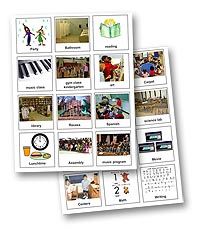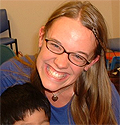A Kindergartener’s Visual Schedule to Decrease Perseveration About Recess
A day in Kindergarten can be a chaotic and ever-changing experience. This is especially true for many of the school-age children with autism that I work with every day. This has caused a bit of apprehension for some of these children! Suddenly we are battling the new environment of full day school which often includes 20 other peers, more work demands, noisy cafeterias, and recess.
For one child in particular, the only part of this new school environment worth mentioning was recess. He was particularly fond of recess (who isn’t?) and going home with his Grandmother. Unfortunately for him, these two things only happen once per day, and the remaining day is spent in all of the unpreferred activities such as writing workshop and art class. This child’s solution to the problem was to continually remind me of his favorite periods of the day and to req
uest them throughout the day! Those of us in the field would call these constant friendly reminders perseveration. So as a result, I needed a way to modifying his school environment to increase the length of time that he spent talking about things other than recess and going home! As his consultant, I began collaborating with his teacher to find a way to make the day a bit clearer for him and a way for us to redirect him without engaging in disruptive conversation. With the help of Mrs. Riley, I decided to make him a small visual schedule of his day.
Visual schedules are often recommended for many children with Autism due to their difficulty with transitions. However, in this case, I saw the visual schedule as a way to present the entire day to this child and remind him of when each activity occurred. Using Mrs. Riley, I created a few templates with picture images of all the parts of his day. Once I had all the pictures printed (even for future events such as assembly), I cut out each activity. These activities and a long strip of paper were all laminated to keep them durable and strong. Once a small square of Velcro© was placed on the back of each activity and on the front of the strip, we had a system that would allowed us to create an individualized schedule for this Kindergartener. Each morning we show him his schedule and if he begins to talk about the R-word or going home, we ignore his comments and without a word show him his trusty schedule. With the visual schedule, he is aware that recess will occur (after arrival, calendar, jobs, writing, and work) and that he will go home (after lunch, centers, math, and gym). The schedule also takes out the verbal component and allows us to provide minimal attention to the perseveration and redirect this child more appropriately. We also incorporated his energy and eagerness for predictability into the schedule by allowing him to remove the activity from the strip once the activity was finished. He then takes these activities and places them in a bag labeled “Alldone.”
This visual support for his day has greatly helped with decreasing his perseveration. It also has helped with his willingness to push through work activities as he is able to see that following difficult tasks such as writing are activities such as lunch. Eventually when he is familiar with his schedule and begins to enjoy other parts of the day, the photos will be faded and he will use a more normalized visual support for his age such as a planner or a written schedule. But for now, he is perfectly happy to glance at his schedule and patiently wait (quietly) for the much anticipated recess time photo!

I am a behavior analyst and currently work as an Autism consultant. This means that my days are constantly spent modifying, increasing, decreasing, and teaching behavior. From teaching a child how to verbally communicate to decreasing aggression to increasing the variety of play actions with a toy set; these are all areas in which I find myself analyzing behavior. In the process, I also find myself supporting and collaborating with many other people who are a part of these children’s’ lives. My work leads me into children’s homes, their day cares, community places, and elementary schools.

